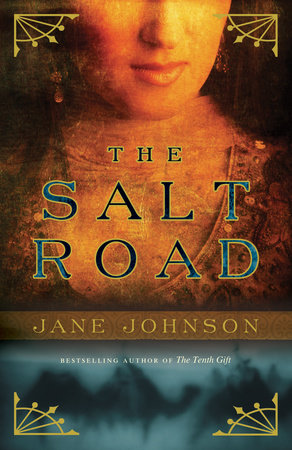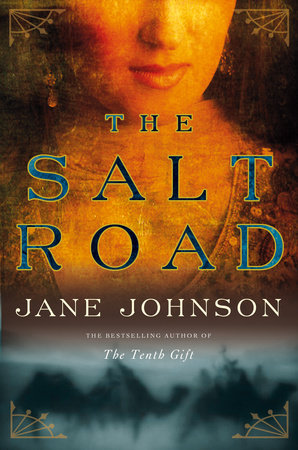THE SALT ROAD
Jane Johnson
Unusual events carried me to a remote corner of the North African continent, events that were to change my life completely.
I had travelled to Morocco (my first time ever in Africa) in order to research piece of family history. In a raid in 1625 an ancestor of mine was stolen, along with 59 other men, women and children, out of a church in Penzance by Barbary corsairs and sold into the white slave markets of Salé/Rabat in northern Morocco. (The subsequent novel was published as The Tenth Gift and sold in 24 countries.) A curious combination of coincidences carried me to a remote Berber mountain village in the far south-west of Morocco.
My travelling companion was my rock-climbing partner, with whom I had scaled cliffs and outcrops all over Britain, and especially my native Cornwall. I had come upon a climbing guidebook to a place called Tafraout which offered not only a myriad of challenging routes in a spectacular mountain environment but also a chance to experience the authentic Morocco – the ancient Berber culture of the country, now to be found in unadulterated form only in a few largely mountainous communities.
And there, in a village 800 miles away from my primary reason for visiting the continent in the first place, I met and fell in love with Abdellatif, a local Berber tribesman. The circumstances of our meeting and burgeoning romance are told in greater detail on my website (www.janejohnsonbooks.com). It started with an epic climbing adventure in which I nearly died (and vowed to change my life if I survived) and culminated in a 3-day wedding barely 6 months later. Shortly after that first visit I returned to the UK, quit my job as a full-time publishing executive chained to a desk, sold my flat and shipped the contents to Morocco. It was a dramatic shift of lifestyle, and identity. From being Jane Johnson, Publishing Director of Fiction at HarperCollins, I was suddenly Mme Zaina Bakrim, the only European woman to inhabit my husband’s village.
The germ of The Salt Road was born at the same time as that research visit for The Tenth Gift, and felt like a gift in its own right. My husband, Abdellatif (Abdel for short), is a Berber of the Chleuh tribe, but one side of his family were nomadic traders from Mauritania. I knew little about the mysterious veiled traders known as the Tuareg before I met Abdel: but I was fascinated when one day, cleaning the old house where his elderly mother still lives, Abdel brought me what looked like a big stone. “What do you think it is?” he asked me (in French, our lingua franca).
It looked like a chunk of rock crystal, and I said so.
He laughed. “It is salt, from the Taodenni salt mine in the deep Sahara,” he told me. “My grandfather traded in salt.”
And then he told me about the salt roads – the trade routes followed for centuries by the Tuareg traders across the desert to reach the market towns of Morocco, and thence the Mediterranean coast. Caravans of camels plied these routes bringing salt, slaves, gold and silver, animal skins, amber and ostrich feathers. It was a dangerous business: as well as the desert’s own well-documented perils – sandstorms, shifting topography, lack of water, murderous heat – there were also bandits and foreign soldiers to contend with.
The Berbers are the indigenous people of North Africa, pre-dating the Phoenicians, the Romans, the Islamic invasion of the 8th century; those Berbers who fled the invaders and headed out into the deserts became known as the Tuareg, a perjorative term applied to them by the Arabs, meaning ‘the abandoned by God’. The Tuaregs prefer the use of the terms Imazaghan – the Free People; or the Kel Tamacheq – ‘Those who speak Tamacheq’. Legend has it that the first Tuareg communities were founded by a young Berber woman called Tin Hinan who walked 1500 miles from her home town in the Tafilalt in southern Morocco out into the desert to avoid being married against her will to the son of the local Roman governor, and there founded a settlement outside what is now Abalessa in the south of Algeria. Her gravesite (dating from the 4th century) was excavated in the 1930s. In the grave there was found a wooden bed, a tall female skeleton decorated with massive bracelets of gold and antimony and a splendid necklace. Among objects beside her was a bowl filled with coins bearing the effigy of the Emperor Constantine.
The Tuareg still venerate Tin Hinan, and trace their lineage back to her. Their homage to her is enshrined in the culture. It was a remarkable feat: the bravery, determination and fortitude shown by Tin Hinan still forms the basis of Tuareg values; in addition, traditionally and very unusually, they are a matrilineal culture, both status and possessions being conferred via the female rather than the male line. In Tuareg society the men go veiled and the women do not (quite the opposite to all other Muslim peoples); and women enjoy a remarkable degree of freedom and prestige. The men’s veil – the tagelmust – a length of indigo cloth wound about the head and face leaving only their kohl-rimmed eyes and the top of the nose exposed, protects not only against the harsh desert sands but also serves to ward off the evil eye and malevolent spirits. Throughout history, the image of a veiled Tuareg man astride his camel, robe rippling in the wind, has been an iconic image of the Saharan landscape.
Up to the 19th century the Tuareg fit this romantic image: they were the kings of the desert, roaming far and wide across the Sahara with their flocks and herds, governing the trade routes and the hidden wells without which no one can survive in the desert, free from interference or influence from the modern world. Gradually their rights and territories have been eroded; their way of life has been threatened, their lands appropriated by mining companies and governments; they have been corralled, abused and marginalized. In the 1990s they have been the victims of attempted genocide, something barely spoken of outside the African continent. Everyone has heard of the atrocities committed in Rwanda, the Congo, Darfur; but have you every heard about the massacre of Tuaregs at Tchin Tabaradene?
Despite their proud heritage, today the Tuareg are fighting for survival. The UN has designated them a ‘Fourth World nation’: by definition an internationally unrecognized nation maintaining a distinct political culture within the states which claim their territories. The Tuareg are engaged in a struggle to gain some degree of sovereignty over their traditional homelands: their struggle has led to many incidents defined as terrorism by those opposed to granting the nomads their territorial and human rights. It’s a struggle largely invisible to the outside world: but at one iconic moment saw a rebel band of Tuareg warriors face up the full might of the army of Mali, tanks and all.
Researching The Salt Road has not only opened my eyes to another culture but has also afforded me invaluable insights into my husband’s family history. It’s introduced me to the music of Tinariwen and Toumast. (YouTube links: http://www.youtube.com/watch?v=-MHAKNL-Vkg&feature=related and http://www.youtube.com/watch?v=FRqiqHZhKOM&feature=related)
In 2008 I fulfilled a long-held dream: to sleep beneath the desert stars, when in 2008 Abdel and I trekked for 3 weeks in southern Morocco, including for some time with a nomad family and their camels as I prepared to write The Salt Road. It is an experience that will remain sharply etched on my memory for ever (as will the physical effects on my hindquarters on learning to master a bony old camel!).
Link to photoset on Flickr:
http://www.flickr.com/photos/organize/?start_tab=one_set72157606436429731
THE SALT ROAD
Jane Johnson
Unusual events carried me to a remote corner of the North African continent, events that were to change my life completely.
I had travelled to Morocco (my first time ever in Africa) in order to research piece of family history. In a raid in 1625 an ancestor of mine was stolen, along with 59 other men, women and children, out of a church in Penzance by Barbary corsairs and sold into the white slave markets of Salé/Rabat in northern Morocco. (The subsequent novel was published as The Tenth Gift and sold in 24 countries.) A curious combination of coincidences carried me to a remote Berber mountain village in the far south-west of Morocco.
My travelling companion was my rock-climbing partner, with whom I had scaled cliffs and outcrops all over Britain, and especially my native Cornwall. I had come upon a climbing guidebook to a place called Tafraout which offered not only a myriad of challenging routes in a spectacular mountain environment but also a chance to experience the authentic Morocco – the ancient Berber culture of the country, now to be found in unadulterated form only in a few largely mountainous communities.
And there, in a village 800 miles away from my primary reason for visiting the continent in the first place, I met and fell in love with Abdellatif, a local Berber tribesman. The circumstances of our meeting and burgeoning romance are told in greater detail on my website (www.janejohnsonbooks.com). It started with an epic climbing adventure in which I nearly died (and vowed to change my life if I survived) and culminated in a 3-day wedding barely 6 months later. Shortly after that first visit I returned to the UK, quit my job as a full-time publishing executive chained to a desk, sold my flat and shipped the contents to Morocco. It was a dramatic shift of lifestyle, and identity. From being Jane Johnson, Publishing Director of Fiction at HarperCollins, I was suddenly Mme Zaina Bakrim, the only European woman to inhabit my husband’s village.
The germ of The Salt Road was born at the same time as that research visit for The Tenth Gift, and felt like a gift in its own right. My husband, Abdellatif (Abdel for short), is a Berber of the Chleuh tribe, but one side of his family were nomadic traders from Mauritania. I knew little about the mysterious veiled traders known as the Tuareg before I met Abdel: but I was fascinated when one day, cleaning the old house where his elderly mother still lives, Abdel brought me what looked like a big stone. “What do you think it is?” he asked me (in French, our lingua franca).
It looked like a chunk of rock crystal, and I said so.
He laughed. “It is salt, from the Taodenni salt mine in the deep Sahara,” he told me. “My grandfather traded in salt.”
And then he told me about the salt roads – the trade routes followed for centuries by the Tuareg traders across the desert to reach the market towns of Morocco, and thence the Mediterranean coast. Caravans of camels plied these routes bringing salt, slaves, gold and silver, animal skins, amber and ostrich feathers. It was a dangerous business: as well as the desert’s own well-documented perils – sandstorms, shifting topography, lack of water, murderous heat – there were also bandits and foreign soldiers to contend with.
The Berbers are the indigenous people of North Africa, pre-dating the Phoenicians, the Romans, the Islamic invasion of the 8th century; those Berbers who fled the invaders and headed out into the deserts became known as the Tuareg, a perjorative term applied to them by the Arabs, meaning ‘the abandoned by God’. The Tuaregs prefer the use of the terms Imazaghan – the Free People; or the Kel Tamacheq – ‘Those who speak Tamacheq’. Legend has it that the first Tuareg communities were founded by a young Berber woman called Tin Hinan who walked 1500 miles from her home town in the Tafilalt in southern Morocco out into the desert to avoid being married against her will to the son of the local Roman governor, and there founded a settlement outside what is now Abalessa in the south of Algeria. Her gravesite (dating from the 4th century) was excavated in the 1930s. In the grave there was found a wooden bed, a tall female skeleton decorated with massive bracelets of gold and antimony and a splendid necklace. Among objects beside her was a bowl filled with coins bearing the effigy of the Emperor Constantine.
The Tuareg still venerate Tin Hinan, and trace their lineage back to her. Their homage to her is enshrined in the culture. It was a remarkable feat: the bravery, determination and fortitude shown by Tin Hinan still forms the basis of Tuareg values; in addition, traditionally and very unusually, they are a matrilineal culture, both status and possessions being conferred via the female rather than the male line. In Tuareg society the men go veiled and the women do not (quite the opposite to all other Muslim peoples); and women enjoy a remarkable degree of freedom and prestige. The men’s veil – the tagelmust – a length of indigo cloth wound about the head and face leaving only their kohl-rimmed eyes and the top of the nose exposed, protects not only against the harsh desert sands but also serves to ward off the evil eye and malevolent spirits. Throughout history, the image of a veiled Tuareg man astride his camel, robe rippling in the wind, has been an iconic image of the Saharan landscape.
Up to the 19th century the Tuareg fit this romantic image: they were the kings of the desert, roaming far and wide across the Sahara with their flocks and herds, governing the trade routes and the hidden wells without which no one can survive in the desert, free from interference or influence from the modern world. Gradually their rights and territories have been eroded; their way of life has been threatened, their lands appropriated by mining companies and governments; they have been corralled, abused and marginalized. In the 1990s they have been the victims of attempted genocide, something barely spoken of outside the African continent. Everyone has heard of the atrocities committed in Rwanda, the Congo, Darfur; but have you every heard about the massacre of Tuaregs at Tchin Tabaradene?
Despite their proud heritage, today the Tuareg are fighting for survival. The UN has designated them a ‘Fourth World nation’: by definition an internationally unrecognized nation maintaining a distinct political culture within the states which claim their territories. The Tuareg are engaged in a struggle to gain some degree of sovereignty over their traditional homelands: their struggle has led to many incidents defined as terrorism by those opposed to granting the nomads their territorial and human rights. It’s a struggle largely invisible to the outside world: but at one iconic moment saw a rebel band of Tuareg warriors face up the full might of the army of Mali, tanks and all.
Researching The Salt Road has not only opened my eyes to another culture but has also afforded me invaluable insights into my husband’s family history. It’s introduced me to the music of Tinariwen and Toumast. (YouTube links: http://www.youtube.com/watch?v=-MHAKNL-Vkg&feature=related and http://www.youtube.com/watch?v=FRqiqHZhKOM&feature=related)
In 2008 I fulfilled a long-held dream: to sleep beneath the desert stars, when in 2008 Abdel and I trekked for 3 weeks in southern Morocco, including for some time with a nomad family and their camels as I prepared to write The Salt Road. It is an experience that will remain sharply etched on my memory for ever (as will the physical effects on my hindquarters on learning to master a bony old camel!).
Link to photoset on Flickr:
http://www.flickr.com/photos/organize/?start_tab=one_set72157606436429731

























